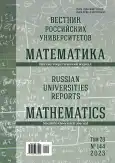Study of the boundary value problem for a differential inclusion
- Authors: Serova I.D.1
-
Affiliations:
- Derzhavin Tambov State University
- Issue: Vol 28, No 144 (2023)
- Pages: 395-405
- Section: Original articles
- URL: https://bakhtiniada.ru/2686-9667/article/view/296477
- DOI: https://doi.org/10.20310/2686-9667-2023-28-144-383-394
- ID: 296477
Cite item
Full Text
Abstract
The boundary value problem with respect to an absolutely continuous function $x:[a,b]\to \mathbb{R}^n$ for the differential inclusion
with the condition $ \alpha x(a) +\beta x(b)=\widetilde{\gamma}$ and additional restriction on the derivative of the desired function $ (\mathcal{L}x)(t)\doteq \dot{x }(t) - \lambda x(t) \in B(t),$ $t \in [a,b]$ is under discussion. It is assumed that the boundary value problem with the same conditions for the linear differential equation $\mathcal{L}x =y$ is uniquely solvable for any summable function $y.$ Using Green's function of this <
\noindent In the first section of the work, the information about multivalued mappings of partially ordered spaces used in this study is given.
\noindent In the main section of the work, conditions for the existence and estimates of solutions to the boundary value problem under investigation are obtained in the form of a statement similar to Chaplygin’s theorem on differential inequality. These results are illustrated by an example of studying a periodic boundary value problem for a differential equation which is not resolved with respect to the derivative.
About the authors
Irina D. Serova
Derzhavin Tambov State University
Author for correspondence.
Email: irinka_36@mail.ru
ORCID iD: 0000-0002-4224-1502
Post-Graduate Student, Functional Analysis Department
Russian Federation, 33 Internatsionalnaya St., Tambov 392000, Russian FederationReferences
- V.I. Arnold, Additional Chapters of the Theory of Ordinary Differential Equations, Nauka Publ., Moscow, 1978 (In Russian).
- A.A. Davydov, “Singularities of Limiting Directions of Generic Higher Order Implicit ODEs”, Proc. Steklov Inst. Math., 236 (2002), 124–131.
- A.A. Davydov, “Normal form of a differential equation, not solvable for the derivative, in a neighborhood of a singular point”, Funct. Anal. Appl., 19:2 (1985), 81–89.
- L. Dara, “Singularites generiques des equations differentielles multiformes”, Bol. Soc. Bras. Mat., 6:2 (1975), 95–128.
- A.O. Remizov, “Many-dimensional poincarґe construction and singularities of lifted fields for implicit differential equations”, Journal of Mathematical Sciences, 151:6 (2008), 3561–3602.
- A.O. Remizov, “Implicit differential equations and vector fields with non-isolated singular points”, Sb. Math., 193:11 (2002), 1671–1690.
- W. Walter, “Differential and integral inequalities”, Journal of Fluid Mechanics, 48:2 (1970), 710–713.
- E. Beckenbach, R. Bellman, Inequalities, Mir Publ., Moscow, 1965 (In Russian).
- Ya. D. Mammadov, S. Ashirov, S. Atdaev, Inequality theorems, Ylym Publ., Ashkhabad, 1980 (In Russian).
- S.A. Chaplygin, “Foundations of a New Method of Approximate Integration of Differential Equations”, Collected works. V. I, Gostekhizdat, M., 1948, 348–368 (In Russian).
- E.S. Zhukovskiy, “On ordered-covering mappings and implicit differential inequalities”, Differ. Equ., 52:12 (2016), 1539–1556.
- E.S. Zhukovskiy, E.A. Pluzhnikova, “On controlling objects whose motion is defined by implicit nonlinear differential equations”, Autom. Remote Control, 76:1 (2015), 24–43.
- S. Benarab, “Two-sided estimates for solutions of boundary value problems for implicit differential equations”, Vestnik rossiyskikh universitetov. Matematika = Russian Universities Reports. Mathematics, 26:134 (2021), 216–220 (In Russian).
- A.V. Arutyunov, E.S. Zhukovskiy, S.E. Zhukovskiy, “On coincidence points of mappings in partially ordered spaces”, Doklady Mathematics, 88:3 (2013), 710–713.
- A.V. Arutyunov, E.S. Zhukovskiy, S.E. Zhukovskiy, “Coincidence points of set-valued mappings in partially ordered spaces”, Doklady Mathematics, 88:3 (2013), 727–729.
- A.V. Arutyunov, E.S. Zhukovskiy, S.E. Zhukovskiy, “On the cardinality of the coincidence set for mappings of metric, normed and partially ordered spaces”, Sb. Math., 209:8 (2018), 1107–1130.
- A.V. Arutyunov, E.S. Zhukovskiy, S.E. Zhukovskiy, “Coincidence points principle for mappings in partially ordered spaces”, Topology and its Applications, 179:1 (2015), 13–33.
- A.V. Arutyunov, E.S. Zhukovskiy, S.E. Zhukovskiy, “Coincidence points principle for set-valued mappings in partially ordered spaces”, Topology and its Applications, 179 (2016), 330–343.
- I.D. Serova, A.A. Repin, “About Existence and Estimates of Solutions of the Implicit Differential Equation With Autoadjustable Deviation Argument”, Vestnik Tambovskogo universiteta. Seriya: estestvennye i tekhnicheskie nauki = Tambov University Reports. Series: Natural and Technical Sciences, 23:123 (2018), 566–574 (In Russian).
- I.D. Serova, “On estimates of the solution of an implicit functional differential equation”, Applied Mathematics and Control Sciences, 2017, №2, 85–93 (In Russian).
- A.A. Andronov, A.A. Vitt, S.E. Hajkin, Oscillation Theory, 2nd. ed., Gos. Izd-vo Fiz.-Mat. Literatury Publ., M., 1959 (In Russian).
- A.D. Piliya, V.I. Fedorov, “Singularities of the field of an electromagnetic wave in a cold anisotropic plasma with two-dimensional inhomogeneity”, JETP, 33:1 (1971), 210–215.
- E.O. Burlakov, E.S. Zhukovskiy, E.A. Panasenko, I.D. Serova, “On order covering set-valued mappings and their applications to the investigation of implicit differential inclusions and dynamic models of economic processes”, Advances in Systems Science and Applications, 22:1 (2022), 176–191.
Supplementary files








